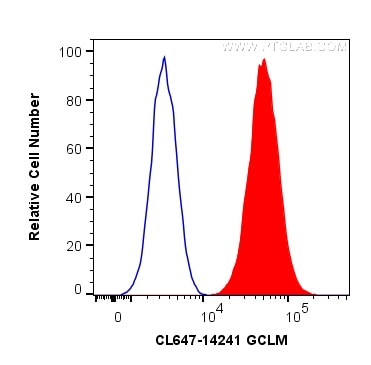Tested Applications
| Positive FC (Intra) detected in | HepG2 cells |
Recommended dilution
| Application | Dilution |
|---|---|
| Flow Cytometry (FC) (INTRA) | FC (INTRA) : 0.20 ug per 10^6 cells in a 100 µl suspension |
| It is recommended that this reagent should be titrated in each testing system to obtain optimal results. | |
| Sample-dependent, Check data in validation data gallery. | |
Product Information
CL647-14241 targets GCLM in FC (Intra) applications and shows reactivity with human, mouse, rat samples.
| Tested Reactivity | human, mouse, rat |
| Host / Isotype | Rabbit / IgG |
| Class | Polyclonal |
| Type | Antibody |
| Immunogen |
CatNo: Ag5497 Product name: Recombinant human GCLM protein Source: e coli.-derived, PET28a Tag: 6*His Domain: 1-274 aa of BC041809 Sequence: MGTDSRAAKALLARARTLHLQTGNLLNWGRLRKKCPSTHSEELHDCIQKTLNEWSSQINPDLVREFPDVLECTVSHAVEKINPDEREEMKVSAKLFIVESNSSSSTRSAVDMACSVLGVAQLDSVIIASPPIEDGVNLSLEHLQPYWEELENLVQSKKIVAIGTSDLDKTQLEQLYQWAQVKPNSNQVNLASCCVMPPDLTAFAKQFDIQLLTHNDPKELLSEASFQEALQESIPDIQAHEWVPLWLLRYSVIVKSRGIIKSKGYILQAKRRGS Predict reactive species |
| Full Name | glutamate-cysteine ligase, modifier subunit |
| Calculated Molecular Weight | 31 kDa |
| Observed Molecular Weight | 31 kDa |
| GenBank Accession Number | BC041809 |
| Gene Symbol | GCLM |
| Gene ID (NCBI) | 2730 |
| RRID | AB_2934891 |
| Conjugate | CoraLite® Plus 647 Fluorescent Dye |
| Excitation/Emission Maxima Wavelengths | 654 nm / 674 nm |
| Form | Liquid |
| Purification Method | Antigen affinity purification |
| UNIPROT ID | P48507 |
| Storage Buffer | PBS with 50% glycerol, 0.05% Proclin300, 0.5% BSA, pH 7.3. |
| Storage Conditions | Store at -20°C. Avoid exposure to light. Stable for one year after shipment. Aliquoting is unnecessary for -20oC storage. |
Background Information
GCLM(Glutamate--cysteine ligase regulatory subunit) is also named as GLCLR and belongs to the aldo/keto reductase family. It catalyzes the first step of GSH synthesis and is involved in gamma-glutamyl cycle. GCLM is implicated in some forms of hemolytic anemia.
Protocols
| Product Specific Protocols | |
|---|---|
| FC protocol for CL Plus 647 GCLM antibody CL647-14241 | Download protocol |
| Standard Protocols | |
|---|---|
| Click here to view our Standard Protocols |




